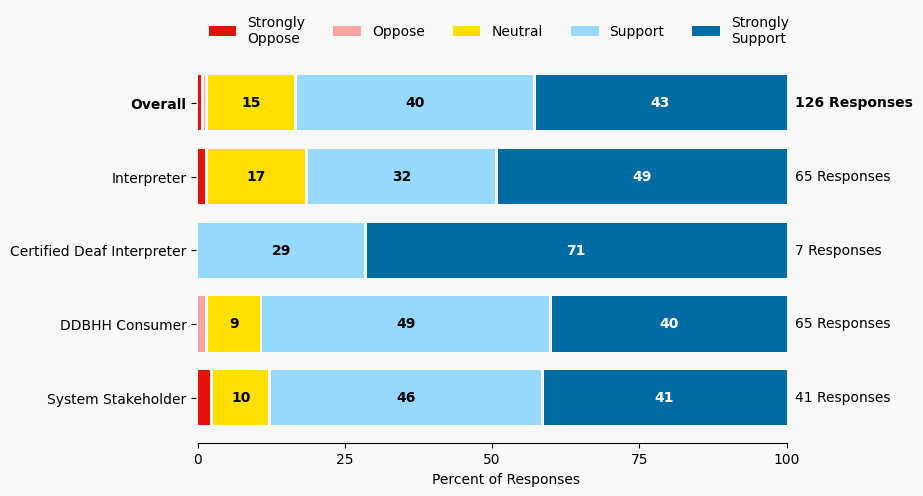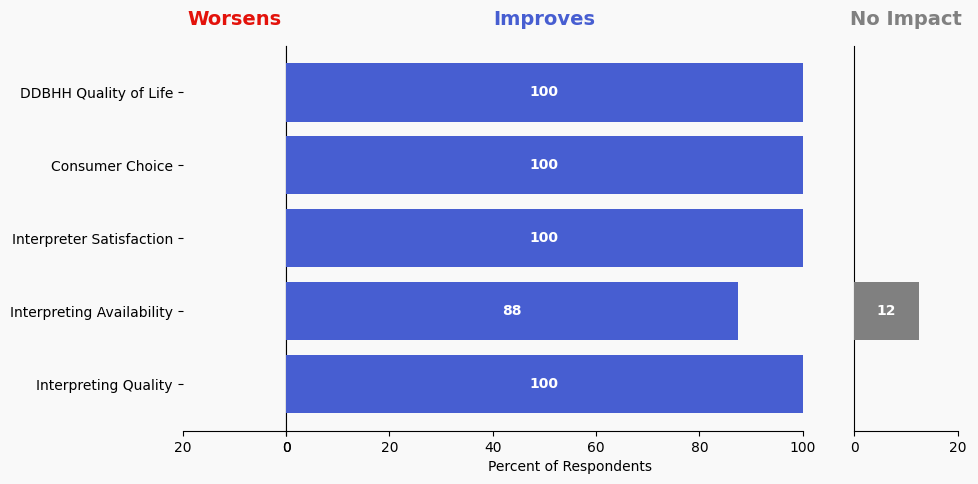47 Develop Best Practices for Certified Deaf Interpreter (CHI) and Certified Hearing Interpreter (CHI) Teams
Issue: There are insufficient best practices regularly used for CDI and CHI team settings
Proposed Solution: A working group led by MRID research existing content and develop best practices for hearing interpreters working with CDIs. This could include potential settings for CDI teams, CDIs having choice on the CHIs with whom they work, preparing, debriefing, and phrases to use for requesting and explaining the benefit of working with a CDI team. This content would be the basis for a curriculum for workshops and lessons in ITPs.
Expected outcome: All new and seasoned hearing interpreters will gain a better understanding of benefits and approaches for working with CDIs, and vice versa. DDBHH consumers receive greater quality of interpreting services.
Who is impacted: Students, new interpreters, experienced interpreters, consumers
Timeline: 6 months

Summary of Support Image Description
The stacked bar charts show how respondents rated their level of support and the total number of responses. The percentage for the five support levels is shown from left to right: Strongly Oppose (Dark Red), Oppose (Light Red), Neutral (Yellow), Support (Light Blue), and Strongly Support (Dark Blue).
Respondents may identify with multiple subgroups. The overall level of support is:
Overall
Strongly Oppose: 1%
Oppose: 1%
Neutral: 15%
Support: 40%
Strongly Support: 43%
Click to see the detailed image description for each subgroup.
Interpreter
Strongly Oppose: 2%
Oppose: 0%
Neutral: 17%
Support: 32%
Strongly Support: 49%
Certified Deaf Interpreter
Strongly Oppose: 0%
Oppose: 0%
Neutral: 0%
Support: 28%
Strongly Support: 71%
DDBHH Consumer
Strongly Oppose: 0%
Oppose: 2%
Neutral: 9%
Support: 49%
Strongly Support: 40%
System Stakeholder
Strongly Oppose: 2%
Oppose: 0%
Neutral: 10%
Support: 46%
Strongly Support: 41%
Overview of Respondents Opting for In-Depth Solution Analysis
After indicating their support level, 6% of the 126 respondents opted in to further assess whether the solution would worsen or improve on five metrics. Of the opt-in reviewers (8 respondents), 75% supported the solution, 25% were neutral on the solution, and 0% opposed the solution.
The remaining 118 respondents did not opt in to further assess the solution. Of these people, 83% support the solution, 14% were neutral on the solution, and 1% opposed the solution.
Reviewer Evaluation of Solution Effectiveness

Solution Effectiveness Image Description
The stacked bar charts show how respondents assessed the effectiveness of this solution based on five metrics. For each metric, the percentage of respondents is shown from left to right: Worsens (Red), Improves (Blue), No Impact (Gray).
DDBHH Quality of Life
Makes It Worse 0%
Makes It Better 100%
No Impact 0%
Interpreter Satisfaction
Makes It Worse 0%
Makes It Better 100%
No Impact 0%
Consumer Choice
Makes It Worse 0%
Makes It Better 100%
No Impact 0%
Interpreting Availability
Makes It Worse 0%
Makes It Better 87%
No Impact 12%
Interpreting Quality
Makes It Worse 0%
Makes It Better 100%
No Impact 0%
Reviewer Feedback and Insights
Interpreter
Comments from Interpreters highlight the need for a centralized, easily accessible resource for Deaf Interpreter/Hearing Interpreter teaming information, as existing resources often get lost or become outdated. Suggestions include conducting research and community-based projects to improve training for Certified Hearing Interpreters (CHIs) and Certified Deaf Interpreters (CDIs).
Deaf, DeafBlind, Hard of Hearing
Comments from DDBHH Consumers praise the idea and note that some interpreters need to relearn how to work effectively with CDIs. One comment suggests include launching community-based projects to train CHIs on working with DIs and encouraging partnerships between MRID and local Deaf Interpreter groups.
System Stakeholder
Comments from System stakeholders suggest there is sufficient information available on DI/HI teaming but emphasize the importance of compiling it into a lasting resource.
PREVIOUS SOLUTION
46 Promote K12 Educational Certified Deaf Interpreters
Issue: Some DDBHH students require interpreting skills that can only be provided by Certified Deaf Interpreters (CDIs). Currently, there are challenges with school districts hiring CDIs despite legislation in place to provide for CDIs in classrooms and the funding reimbursement to school districts for CDI services.
NEXT SOLUTION
48 Provide ProTactile and Communication Intensive Trainings for DeafBlind Minnesotans
Issue: Many DeafBlind individuals do not always have exposure to ProTactile. Often interpreters have greater access to training than DeafBlind Minnesotans. Some DeafBlind consumers may not always know what communication works best for them if they haven’t had exposure, nor do they have training on how to instruct interpreters to work with them best. Often, interpreters walk into assignments with DeafBlind individuals not knowing what communication works best for them, resulting in frustration and potentially failed communication on both sides.
Leave a Reply